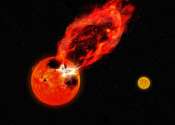Active asteroid unveils fireball identity
At around 1 a.m. local standard time on April 29, 2017, a fireball flew over Kyoto, Japan. Compared to other fireballs spotted from Earth, it was relatively bright and slow. Now, scientists have determined not only what the ...









